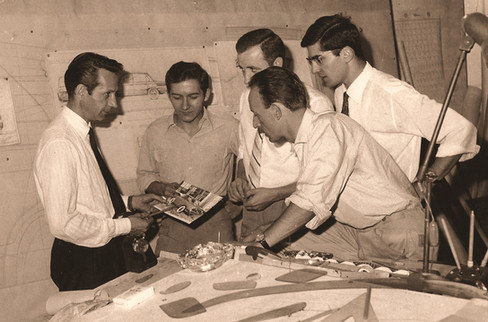In 1949, Giovanni Michelotti embarked on his freelance career, marking the beginning of a successful journey in automotive design. With the establishment of the "Laboratorio Automodelli" in Turin in 1959, he created a hub of innovation that would give rise to legendary prototypes. Architect Edgardo Michelotti sheds light on this pivotal moment in Carrozzeria Michelotti’s history and its impact on the automotive world.
Words Edgardo Michelotti
Photos and drawings Archivio Storico Michelotti (http://www.archiviostoricomichelotti.it/)

I had the privilege of witnessing the most significant years of my father Giovanni Michelotti’s career up close, and I am here to recount a crucial moment that marked his professional evolution: the founding of his coachbuilding firm. Reflecting on those years and revisiting the drawings of the vehicles created during that time constantly reaffirms for me how essential that period was—not just for our family but for the entire automotive design world.
After twelve years working at Stabilimenti Farina (1936-1948), where he honed his craft and learned the importance of detail, in 1949 he made a life-altering decision: to embark on an independent career as a freelance designer.
He was just 28 years old but already had a clear vision of what he wanted to achieve. Over the next fifteen years, he collaborated with nearly all of Turin's coachbuilders—a city that, during the 1950s and '60s, was the epicentre of automotive innovation. I recall his discussions with the great names of the era, where they would spend hours talking about shapes, curves, and aerodynamic solutions. Michelotti had a deep affection for Turin, a city that provided him with the challenges and opportunities he needed to express his creativity.
In 1957, he experienced a major turning point. He began working as a consultant for leading international car manufacturers such as BMW, Standard Triumph, Prince, Ford, and Alpine. Not long after, in 1965, the Dutch company DAF also joined his client list, which I will cover in a future article. He wasn’t content with simply creating something beautiful; he focused on functional, modern solutions that appealed to international tastes.
It was during this time that he realised the importance of having dedicated spaces for developing prototypes destined for major manufacturers. Previously, these projects were entrusted to trusted coachbuilders like Vignale and Allemano, but there was always the risk that his designs could be seen and copied.
He decided to open his own "Laboratorio Automodelli" at Via Levanna 2 in Turin. This workshop, staffed by seven master craftsmen, became a nerve centre for creativity and innovation. Each team member had a specific role: panel beaters, welders, and assemblers worked in synergy to bring the designer's ideas to life. It was a space dedicated to creating prototypes for discerning clients who aspired to "stand out" with special vehicles.

That same year, he also relocated his design and styling studio from our family home on Corso Duca degli Abruzzi to a penthouse on the eleventh floor of a building on Corso Francia—a space that offered both privacy and a perfect environment for work.
From his studio, he enjoyed breathtaking views of the entire Alpine range surrounding Piedmont, a panorama often mentioned in his conversations as a source of reflection and inspiration.

The studio quickly became one of the most important in Europe, attracting interest from car manufacturers seeking innovative and functional solutions.

My father loved sharing his passion with young talent, encouraging them to experiment and bring their ideas to life in an environment where learning and creativity naturally intertwined.

Under his guidance, embryonic concepts, colourful sketches, and shape plans took form and transformed into complete automotive projects. In his atelier, prototypes that would shape automotive history were born, the result of a collaborative and inspired creative process.

One of the most significant prototypes produced during those years was the Fiat Osca coupé, presented at the Paris Motor Show in 1959 and at Geneva in 1960.
The car, with its modern front and "pagoda" roof, became a reference for many manufacturers. The Lancia Fulvia coupé, designed by Piero Castagnero in 1963, borrowed many stylistic elements from the Osca, while the Mercedes 230 SL, with its pagoda roof, unveiled that same year at the Geneva Motor Show, confirmed the success of Michelotti’s innovation.

My father often recounted an episode linked to the Osca Coupé: French journalist Alain Bertaut initially criticised the roof design, but Michelotti made a deal with him. If other manufacturers adopted the design, Bertaut would publicly acknowledge Michelotti as the originator. And so it happened—Mercedes adopted the pagoda style, and Bertaut kept his promise. It was a time when intellectual honesty still held great value.
Another important chapter in his career was marked by his involvement in racing. During the 1960s, track and hill-climb racing was highly popular, and my father contributed to the creation of models like the Triumph Le Mans coupé and the Alfa Romeo Giulietta Sprint Veloce, both prepared by Virgilio Conrero.

I clearly remember Carlo Peroglio, the driver of the latter, telling us about his feats at Monza, where the Alfa Romeo, mainly driven by Peroglio, surpassed the Alfa Abarth Zagato at a speed of 222 km/h.


This success did not go unnoticed: Carlo Abarth called my father in and asked him what he had "put inside" the car to make it so fast. The answer was clear and direct—it was all down to aerodynamics and lightness.
Among the most significant collaborations with Triumph, in addition to defining the style of some of the brand’s most iconic models, such as the Spitfire, Herald, and TR4, an important chapter was the creation of the Le Mans coupé, a model developed specifically for endurance racing.


This car represented the perfect synthesis of elegance and performance—qualities that Michelotti masterfully combined.
Michelotti never ceased to innovate. Another example of his genius was the prototype on a Maserati 5000 GT chassis created for Briggs Cunningham. The retractable pop-up headlights were a true innovation for the time, once again demonstrating his ability to anticipate automotive design trends.

Today, these vehicles remain in the hands of collectors in Switzerland and the United States, and they are still fully functional.
The exhibition "Giovanni Michelotti: Genie et Élégance," held in Aigle, Switzerland, in 2022, paid tribute to the centenary of his birth. The Alfa Romeo Conrero, one of the models on display, still stands as a testament to his ability to create cars that harmoniously combined beauty and performance.
About tha author Edgardo Michelotti: Born in 1952, I hold a diploma as a surveyor and pursued a degree in Architecture in Turin. I began working alongside my father in 1973 until his illness and passing in early 1980. I continued his work until 1991, when I transitioned away from the automotive industry. For the next 15 years, I focused on industrial design, while also engaging in photography and archival digitization from 2003 to the present. This allowed me to manage an extensive archive, including the specific cataloging and complete digitization of approximately 6,000 graphic units, 20,000 photographs, 7,000 kg of full-scale design plans, as well as scale models, tools, correspondence, and periodicals. The archive spans over three decades, covering the 1950s, 60s, and 70s.







































Comments